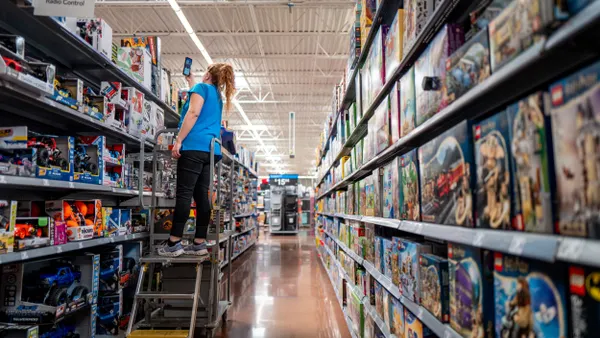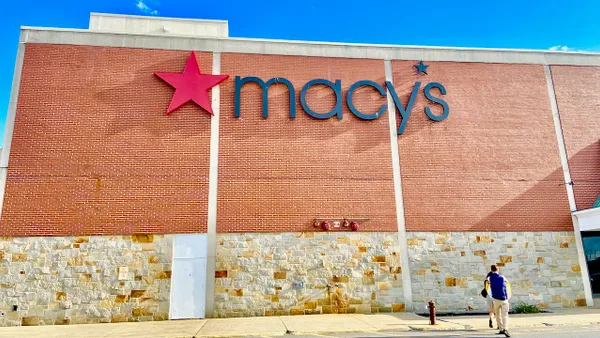The table at Pottery Barn is strewn with decorative, silver trees on a table runner of white cotton. It's a snow globe outside of the glass. Candles line the shelves behind the table, and the overhead lighting gives off a soft glow. The tableau is cozy and warm and it reminds you of decorating for the holidays when you were a kid. You find yourself thinking, "Wait, would my aunt like one of those candles?"
That's the power of visual merchandising.
Merchandising, at its core, utilizes product placement and displays to drive sales. It's an art form that draws on data, understanding what drives shoppers and creative problem-solving. When done well it pushes a brand narrative that evokes something joyous and personal. It can also provide touchpoints so consumers understand how to interact with products, especially at a time when shoppers are distracted.
"The intention of visual merchandising is to create strike points and generate ideas for the shopper," said Doug Hope, senior vice president of Emerald Expositions and RetailX show director. "It's very effective to be able to do that at the holidays because it tends to be a pretty rich and deep merchandising environment."
The importance of visual merchandising
Visual merchandising tells the story of a brand. It's about product placement in a store, sure, but the larger goal speaks to enveloping a shopper in an experience.
And retailers are increasingly about that experience. This year Casper opened a sleeping lounge in New York City called the "Dreamery" where customers are encouraged to pay to take a nap. Beauty brand Glossier introduced a flagship store in SoHo where products are surrounded by Instagram-friendly vignettes and shoppers can play with makeup. Nike's House of Innovation also launched recently, and subsequently set a new bar for consumer experience by merging technology, merchandising and product customization.
In a time of increased competition for consumer dollars, thoughtful merchandising can be a key factor for increasing sales. Eric Feigenbaum, president of Embrace Design, and editorial advisor and New York editor of Visual Merchandising and Store Design magazine, said that visual merchandising isn't just about the bottom line, but can create a deep connection with the consumer. "Stores are no longer just a place to sell stuff. They are places for social engagement. They are places to learn, places to interact," he said in an interview with Retail Dive.
Retail more broadly is also focusing on experience. Lululemon is delving deeper into that type of consumer experience in its 5th Avenue store in New York City where shoppers can go to a "zen pod" and sit through a guided meditation. Sephora also has several Beauty TIP (Teach, Inspire, Play) Workshops where shoppers can learn about products and makeup application techniques. The store also offers workstations that are equipped with Wi-Fi, USB ports, and iPads so customers can browse online and share looks.
A Sonos showroom in SoHo is made in a similar vein, with small rooms customers can go into to test sound quality by listening to music or watching film clips. Retailers are clearly experimenting to better understand and serve their customers, and the genesis of that type of innovation often starts with visual objectives.
Merchandising for the holiday season
There's nothing like the holidays to draw attention to the impact of visual merchandising. It's the time of year when the art form is most apparent and robust. Stores decorate windows, malls create Santa wonderlands and displays become more colorful and complex.
But how stores are participating varies wildly this year. Some are going all out with elaborate displays, while others are more reserved. "I think it's a good barometer of how the store is performing," said Hope.
One retailer that analysts point out for doing a fantastic job with merchandising is Target. Earlier this year the brand revealed a $7 billion strategic plan that included money set aside for in-store improvements. The approach is already paying off. "They really have put together great design ... I would say they really upgraded the overall presentation of the store, along with the seasonal merchandising," said Hope about Target. "There's more trees, there's more lights, there's more holiday decor, and less tendency to just print one-dimensional merchandising."
The slow rollout
Disbelief that Christmas items show up in stores the day after Halloween is an often expressed joke. Holiday displays are seen well in advance of Thanksgiving due to the changing nature of visual merchandising. Staffing, or the lack thereof, is one reason behind the slow-burn feel of a longer season in stores.
"In the 50s and 60s department stores had massive staffs that could roll out an entire store's Christmas decor package on Thanksgiving," said Hope. Now employees don't focus on holiday rollouts on one overnight shift because there aren't enough merchandisers. "They get some people some of the time and then just unfurl different elements of the holiday. Eventually, it becomes a complete holiday look and feel."
This was especially true during the recession of the 2000's, when retail margins were thin. Merchandising programs were pulled back and jobs specializing in that segment of the industry were cut. Funds for merchandising still typically come from marketing budgets rather than capital expenses. Today, holiday visual merchandising duties are commonly contracted out to individuals or small businesses. "The visual industry is a cottage industry," said Hope.
The slow nature of seasonal merchandising means that shoppers may catch a store mid-process. It can be confusing and, at times, look disjointed.
Digital versus online
It may be tempting to think that visual merchandising is the sole purview of brick and mortar retailers. Thanksgiving through Cyber Monday saw record-breaking online sales, and Amazon scored the single biggest shopping day in its history. So, why should retailers spend energy on a dynamic merchandising program?
"It's not digital or brick and mortar. It's digital and brick and mortar. The two must work together," said Feigenbaum. The importance of omnichannel revealed itself this Thanksgiving shopping weekend, with the National Retail Federation reporting the number of consumers making purchases both in-store and online reaching 89.7 million, up almost 40% from last year. Customers are expecting a more fluid experience regardless of where they spend money. It's a notion that is pushing brand cohesiveness — where one space can inform the other.
Nicole Staple, the co-owner of Brideside, a company that sells bridesmaid dresses and accessories, stressed the importance of a comprehensive approach to product offerings regardless of if the customer is in-store or online. "If you want the customer experience to be first-class the inventory has to be completely seamless across all locations, whether it is digital or physical," she said in an interview with Retail Dive earlier in November. "The customer needs to be able to see something online, or see something on social that she loves and come in and be serviced that."
Brands that understand the importance of visual merchandising and invest in it will continue to evolve, said Feigenbaum. "This is a very important time for visual merchandisers. The industry as we know it is changing exponentially. It's those who embrace change that will succeed."













